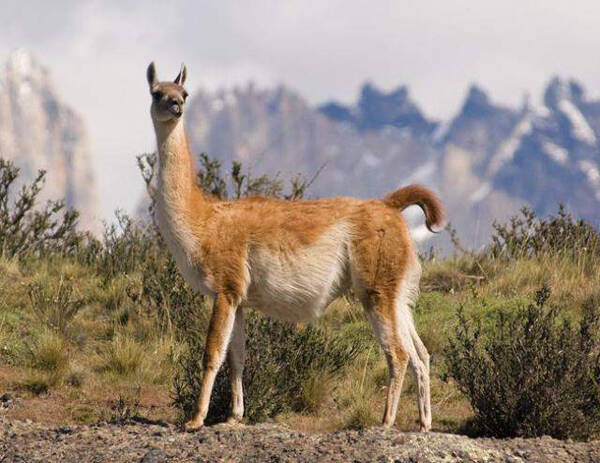Lama guanicoe
IUCN
LCBasic Information
Scientific classification
- name:Lama guanicoe
- Scientific Name:Lama guanicoe,Guanaco
- Outline:Ungulata
- Family:Artiodactyla Camelidae Alpaca
Vital signs
- length:120-225cm
- Weight:100-120kg
- lifetime:About 20 years
Feature
The wild ancestor of domestic camels and alpacas
Distribution and Habitat
Guanacos are native to South America, mainly distributed along the central and western parts of the American continent. In Peru, southern Chile, Bolivia, Argentina, Paraguay and other countries. Most of them live in the Andes Mountains region on the border between Peru and Bolivia. There are also wild populations in the Falkland Islands, Tierra del Fuego and the island of Navarino.
Guanacos live on the west coast of South America, from sea level to highlands over 4,500 meters above sea level. They like to live on grasslands and plateaus at high altitudes, living in arid and semi-arid habitats, including desert grasslands, savannas, shrubs, and forest peripheries. They never go to the woods and avoid rocky areas. Because it likes to be in open areas, it needs to have sensitive senses and run fast to ensure its life safety, with a speed of up to 56 kilometers per hour. Guanacos migrate seasonally to avoid food shortages caused by snow cover or drought, including moving to lower altitu
Appearance
The guanaco is 120-225 cm long, 110-115 cm high at the shoulder, 15-25 cm long tail and weighs 100-120 kg. The largest wild population is in South America. They are an elegant animal with a long neck and long, thin legs. The head is white and grayish black, with white edges around the lips, ears and inner legs. The whole body is covered with a shaggy coat, and the back is light camel or brown. The guanaco, like other camels, has wide pads under its feet, and the sound of the hooves can only be heard when it touches the rocky and gravelly ground.
Details
Guanaco (scientific name: Lama guanicoe) is a docile herbivore with four subspecies.

Guanacos like to form small groups, with 4-10 females led by a male. The territory is marked by the accumulation of feces in the group. Male guanacos fight for territory by colliding with each other and spitting. Young males generally live alone or in male groups, mainly eating grass, shrubs, lichens, cacti and succulents. They are very loyal. It is said that if the leader of the group is shot down, the other females will not run away, but will gather around it and use their noses to push it, trying to make it stand up and walk together.
During migration, a group of about 30 guanacos are formed. They mate between August and September, with a gestation period of 345 to 360 days. Every spring, female guanacos give birth to a single offspring, and the females are ready to mate again within two weeks of giving birth. The young can run after birth. They reach sexual maturity in 12 to 24 months. When the male young grow up, they are driven away and form a group of young males. Their lifespan is about 20 years. They may live up to 28 years in artificial breeding.
Young male guanacos live in bachelor groups for three to four years to prepare their fighting skills, and then compete with other males for dominance, challenging the territorial males who control a group of females. They use their necks to pound their opponents' chests and wrestle, often accompanied by high-pitched screams and low-pitched growls.

The guanaco is widespread, but its numbers declined dramatically starting in the 19th century. The main threats in Bolivia are habitat loss and hunting, in Chile, recreational hunting and poaching are the main threats, and in Peru, poaching is also a serious threat to guanacos. Overhunting, grassland degradation, livestock encroachment and extractive activities, desertification due to overgrazing, which has greatly reduced the range of pastures, have all played a significant role in the demise of the guanaco, and by 1995, the guanaco occupied only 40% of its original range. The patchiness of the distribution area has resulted in relatively isolated populations. Some populations in the south are at serious risk of local or regional extinction. In the Patagonian steppes, increasing pressure from private landowners may lead to threats to the remaining high-density herds.
Listed in the IUCN Red List of Mammals, ver.: 2008 - Low Concern (LC).
Listed in Appendix I, Appendix II and Appendix III of the 2019 edition of the Convention on International Trade in Endangered Species of Wild Fauna and Flora (CITES).
Protect wild animals and eliminate game.
Maintaining ecological balance is everyone's responsibility!








